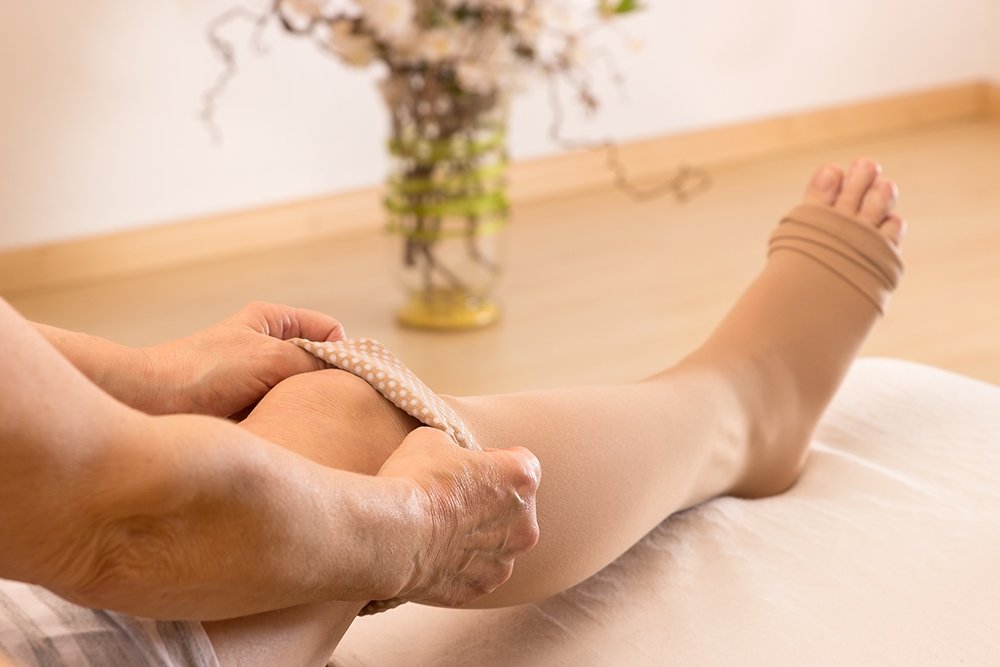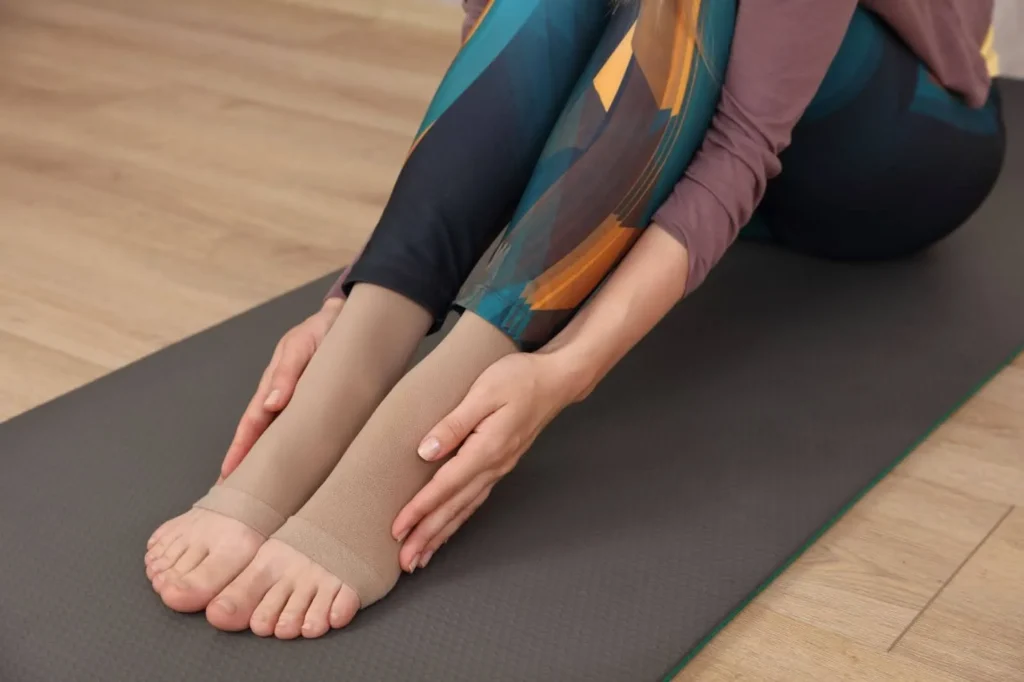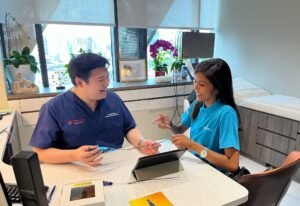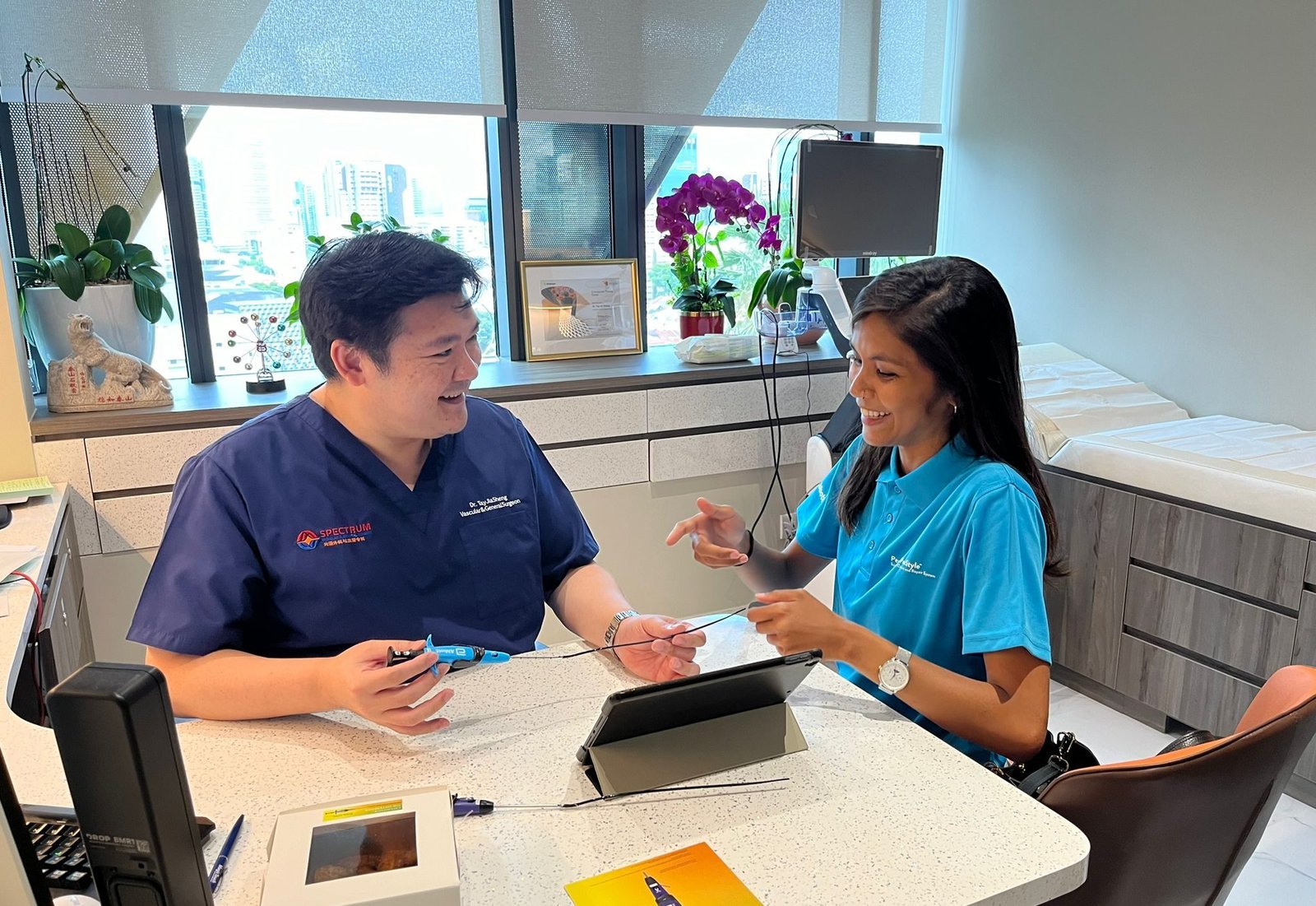
Compression stockings are a helpful first-line treatment for those experiencing varicose veins. If you’re looking to manage symptoms before considering minimally invasive procedures like sclerotherapy or endovenous thermal ablation, compression therapy may be an effective way to start. It offers a simple yet powerful solution to reduce discomfort, improve circulation, and prevent varicose veins from worsening.
In this guide, we’ll explore how compression stockings work, when and how to use them, and what to consider when choosing the right pair for your needs.
Compression stockings are specially designed elastic garments that apply gentle, graduated pressure to the legs. The pressure is strongest at the ankles and decreases up the legs.
This controlled pressure helps support the veins and improve blood flow back to the heart, reduce pooling of blood in the lower limbs, relieve symptoms like heaviness, swelling, and fatigue, and help slow the progression of vein disease.
While compression stockings do not entirely treat varicose veins, they are an effective way to manage symptoms and prevent further deterioration, especially in the early stages.
Compression stockings are most effective for:
Besides the above vein conditions, compression stockings can also be extremely helpful for non-vascular situations like providing relief during pregnancy (especially in the second and third trimesters) and reducing the risk of deep vein thrombosis during long-haul travel.
Compression stockings can relieve symptoms like heaviness, aching, swelling and night cramps. If you suffer from more severe symptoms like ulceration and skin changes, consult a vascular specialist to explore other treatment options.

Compression stockings come in different pressure levels, usually measured in mmHg (millimetres of mercury):
| Compression Level / Pressure Range | Common Uses |
|---|---|
| Mild Pressure range: 8-15 mmHg | Tired, heavy legs, mild swelling |
| Moderate Pressure range: 15-20 mmHg | Mild varicose veins, pregnancy, travel |
| Firm Pressure range: 20-30 mmHg | Moderate to severe varicose veins, post-treatment support |
| Extra Firm Pressure range: 30-40 mmHg | Severe varicose veins, ulcers. Can only be used under medical supervision. |
They also come in various lengths and types; namely knee-high, thigh-high and pantyhose. The appropriate length depends on the extent and location of your varicose veins. For optimal effectiveness, the stocking must cover the entire area affected by visible or bulging veins.
It’s best to consult a vascular specialist to determine the right type and fit of compression stockings for you. Wearing the wrong kind — even an ill-fitting pair — can cause discomfort, skin irritation, and numbness.
Avoid compression stockings if you have severe peripheral arterial disease, advanced diabetic neuropathy, open wounds or severe leg deformities.
It is generally not advised to wear compression stockings to sleep as they are designed for daytime use when you are upright. Exceptions may include post-procedure care or specific conditions, which should be reviewed by your doctor.
Depending on the compression level, compression stockings are generally safe to wear throughout the day. However, taking regular breaks and maintaining proper skin hygiene is important to minimise the risk of irritation or discomfort from prolonged use.
To ensure your compression stockings continue to provide optimal support, it is recommended to hand wash them regularly with mild soap and air dry them flat. Avoid fabric softeners or wringing, and replace them every 3-6 months as the elasticity wears off.
Tip: Consider buying two pairs so you can rotate daily use.
| Before Wearing |
|
| When Wearing |
|
More or less, yes – they serve the same function but differ in terms of their lengths. Compression socks typically refer to knee-high options, while compression stockings may include thigh-high or pantyhose styles.
You can purchase compression stockings over the counter at most retail stores such as Watsons and Decathlon, particularly those with lower compression levels (typically below 20 mmHg). However, stockings with higher compression (above 20 mmHg) require a prescription from a healthcare professional.
Even for over-the-counter options, it’s advisable to consult a vascular specialist to ensure the stockings are appropriate for your condition. This helps maximise their effectiveness while preventing potential complications like skin irritation, restricted blood flow, or tissue damage.
Compression stockings offer a simple yet effective way to manage varicose veins – so you can walk through life with less strain and more gain.
At Spectrum Vascular & General Surgery, our vascular specialist offer a range of tailored treatment plans for varicose veins—including compression therapy, minimally invasive vein treatments, and long-term vascular care.
Contact us to find a solution that fits your lifestyle.


Dr Tay Jia Sheng is a distinguished vascular surgeon in Singapore, specialising in minimally invasive vascular, endovascular and endovenous procedures. He treats a broad range of conditions including varicose veins, deep vein thrombosis, peripheral arterial disease, diabetic foot ulcers and aortic aneurysms.
As a founding vascular surgeon at Sengkang General Hospital, Dr Tay led one of Singapore’s busiest vascular units with strong outcomes and low complication rates. He is among the few local surgeons skilled in advanced techniques such as minimally invasive vein harvesting and complex endovascular aneurysm repairs.
Outside the operating theatre, he has taught at Yong Loo Lin, Duke-NUS and Lee Kong Chian medical schools. Recognised with awards such as the SingHealth Quality Service Award and COVID-19 Resilience Medal, he now practises at Spectrum Vascular & General Surgery, offering patient-centred care with a focus on minimally invasive treatment.


Dr Tay Jia Sheng is a distinguished vascular surgeon in Singapore, specialising in minimally invasive vascular, endovascular and endovenous procedures. He treats a broad range of conditions including varicose veins, deep vein thrombosis, peripheral arterial disease, diabetic foot ulcers and aortic aneurysms.
As a founding vascular surgeon at Sengkang General Hospital, Dr Tay led one of Singapore’s busiest vascular units with strong outcomes and low complication rates. He is among the few local surgeons skilled in advanced techniques such as minimally invasive vein harvesting and complex endovascular aneurysm repairs.
Outside the operating theatre, he has taught at Yong Loo Lin, Duke-NUS and Lee Kong Chian medical schools. Recognised with awards such as the SingHealth Quality Service Award and COVID-19 Resilience Medal, he now practises at Spectrum Vascular & General Surgery, offering patient-centred care with a focus on minimally invasive treatment.
38 Irrawaddy Road
#10-33
Singapore 329563
Tel: +65 6041 0933
1 Farrer Park Station Road
#08-14 Connexion
Singapore 217562
Tel: +65 6974 8859
HP: +65 8874 0371 (24 hours)
Email: contact@spectrum-surgery.com
© 2025 Spectrum Vascular & General Surgery